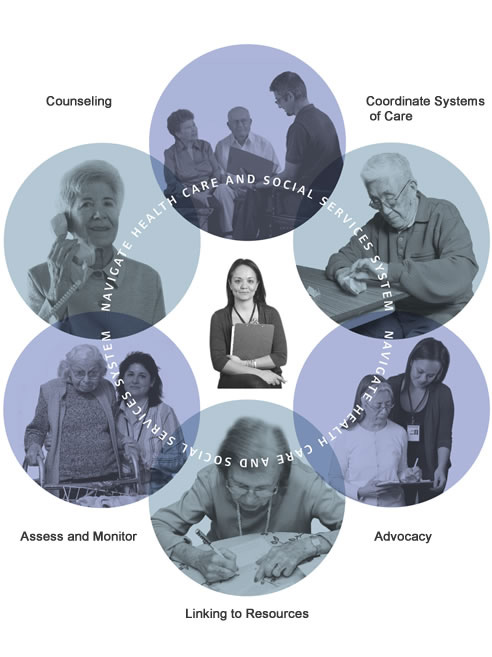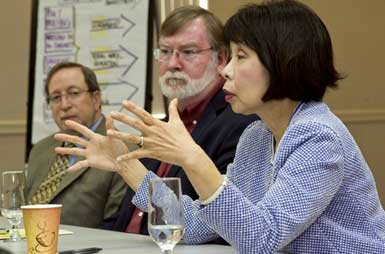In last week’s blog, we introduced you to our 2009 Annual Report, which celebrates the leaders who have integrated geriatric social work principles throughout social work education. Yet to create change within schools of social work, it is not enough sponsor programs for faculty and students. “To be successful in making the programs of the Geriatric Social Work Initiative sustainable, we believed we needed to address all  levels in the educational system,” says Patricia J. Volland, MSW, MBA, Senior Vice President, The New York Academy of Medicine, “including deans and directors.” Volland and Jeannine Melly of the Social Work Leadership Institute at the New York Academy of Medicine, in partnership with the National Association of Deans and Directors (NADD), administer the Leadership Academy in Aging, which offers deans and directors of schools of social work opportunities for leadership development combined with a focus on expanding geriatric social work within their schools.
levels in the educational system,” says Patricia J. Volland, MSW, MBA, Senior Vice President, The New York Academy of Medicine, “including deans and directors.” Volland and Jeannine Melly of the Social Work Leadership Institute at the New York Academy of Medicine, in partnership with the National Association of Deans and Directors (NADD), administer the Leadership Academy in Aging, which offers deans and directors of schools of social work opportunities for leadership development combined with a focus on expanding geriatric social work within their schools.
I have had the pleasure of meeting many of the 24 individuals who have attended the Leadership Academy in Aging so far, and I am equally pleased to have the opportunity to honor them here. They are developing as leaders in the field of geriatric social work and building their capacity to address the needs of older Americans by strengthening the geriatric programs in their schools and communities. Most of these leaders do not have backgrounds in aging, but understand that our rapidly aging population will require well-trained social workers with the knowledge and skills to care for older people. Even today, 75% of social work graduates work with older adults.

One of the assignments of participants in the Leadership Academy is to develop a gerontological project at their school. Michael Forster, Dean, College of Health at the University of Southern Mississippi, built a ‘center on aging’ at the university, giving gerontological social work the benefit of an interdisciplinary setting that includes nursing, nutritional science, audiology, health education, and exercise science/recreation. The result is an enriched perspective on aging and social work’s unique contribution to addressing the needs of whole persons and their families and communities. Francine Vecchiolla, Dean of Springfield College School of Social Work, developed an Area of Emphasis in Gerontology and created a Community of Practice with representatives from social work practice, field education, and gerontological research. These are only two among the many excellent projects created by the first two cohorts of the Leadership Academy. I am grateful that these important leaders have embraced the opportunity to increase the visibility of gerontology at their schools.
The impact of the Leadership Academy also goes beyond universities. Bruce Friedman, Director, Department of Social Work, California State University, Bakersfield, writes, “Being in the Leadership Academy has not only helped to promote the role of aging on campus, but it has also helped to promote it within the state.” Friedman recently accepted an offer from CalSWEC (the California Social Work Education Center) to co-chair their statewide Aging Initiative for the upcoming year.
I am also grateful to the past NADD president, Kathleen Briar-Lawson, and the current president, Alberto Godenzi, who are strong advocates for the work of the Academy and of the Hartford Geriatric Social Work Initiative. Neither had a background in aging, but they are now fully engaged in working with the Hartford Foundation in ensuring that all social workers receive education and training in geriatrics.
Now that deans and directors are embracing the changes needed to ensure that all future social workers are prepared to care for older adults, I am more confident that the gains we have made through the Geriatric Social Work Initiative can be not only sustained, but expanded. The Foundation’s 2009 Annual Report honors all of the leaders who have made the Leadership Academy possible, as well as all of the deans and directors who have either participated in the Academy or have led their schools and communities to provide better care for our older adult population. Thank you all.
Other blogs in this series
- Celebrating a Decade of Leadership in Geriatric Social Work by Nora OBrien-Suric
- Beatrice by Rachael Watman
- Building the Student Pipeline by Nancy Kropf
- A Collaboration That’s Greater Than the Sum of Its Parts by Amy Berman
- Developing a Geriatrics-Trained Workforce by Tracy Schroepfer
